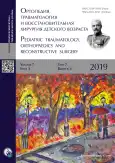Первичный опухолевый (туморальный) кальциноз — редкое заболевание в практике ревматолога и ортопеда: опыт применения ингибитора интерлейкина-1 в сочетании с хирургической коррекцией
- Авторы: Петухова В.В.1, Идрисова Р.В.2, Снегирева Л.С.1, Красногорская О.Л.1, Суспицын Е.Н.1,3, Веселов А.Г.4, Костик М.М.1
-
Учреждения:
- ФГБОУ ВО «Санкт-Петербургский государственный педиатрический медицинский университет Минздрава России»
- СПбГБУЗ «Детская городская больница № 1»
- НМИЦ онкологии им. Н.Н. Петрова
- ФГБОУ ВО «Санкт-Петербургский государственный педиатрический медицинский университет Минздрава России»
- Выпуск: Том 7, № 3 (2019)
- Страницы: 85-92
- Раздел: Клинические случаи
- URL: https://journal-vniispk.ru/turner/article/view/12523
- DOI: https://doi.org/10.17816/PTORS7385-92
- ID: 12523
Цитировать
Аннотация
Обоснование. Первичный опухолевый кальциноз является крайне редким заболеванием. Статистические данные о встречаемости данной патологии, а также клинические рекомендации по лечению в русскоязычной литературе отсутствуют.
Клиническое наблюдение. Представлен клинический случай лечения пациента 11,5 года с первичным опухолевым кальцинозом и эквинусной деформацией левой стопы. Ребенок поступил с жалобами на наличие множественных подкожных кальцинатов, невозможность самостоятельно ходить, утомляемость, подъем температуры до фебрильных цифр, деформацию левой стопы. Проведен комплекс клинико-лабораторного, иммунологического и генетического обследования. После установки диагноза и назначения терапии ингибитором интерлейкина-1β отмечена значительная положительная динамика: общее состояние пациента существенно улучшилось, уменьшилось количество кальцинатов, были купированы воспалительные явления. При обследовании обнаружено, что деформация левой стопы обусловлена кальцификацией ахиллова сухожилия и икроножной мышцы. Для лечения деформации стопы было успешно применено хирургическое лечение.
Обсуждение. В результате комплексного подхода к лечению достигнуто значимое клиническое улучшение. Ребенок самостоятельно ходит, прекратилось образование новых кальцинатов, снизилась утомляемость, был купирован воспалительный процесс. Благодаря применению ингибитора интерлейкина-1β в качестве постоянной терапии первичного опухолевого кальциноза удалось выполнить хирургическое лечение без осложнений со стороны послеоперационной раны, а также предотвратить рецидив деформации.
Заключение. Представленный клинический случай демонстрирует применение междисциплинарного подхода к лечению крайне редкого заболевания. При отсутствии клинических рекомендаций по лечению и диагностике первичного опухолевого кальциноза верификация правильного диагноза и применение комплексного лечения позволили добиться значительного улучшения качества жизни пациента. Мы считаем необходимым сообщить не только о новых эффективных методах лечения, но и информировать специалистов о клинической картине столь редкого заболевания.
Полный текст
Открыть статью на сайте журналаОб авторах
Вероника Витальевна Петухова
ФГБОУ ВО «Санкт-Петербургский государственный педиатрический медицинский университет Минздрава России»
Email: nika_add@mail.ru
ORCID iD: 0000-0002-2358-5529
SPIN-код: 9451-3030
клинический ординатор кафедры хирургических болезней детского возраста им. Г.А. Баирова
Россия, Санкт-ПетербургРена Вагиф Кызы Идрисова
СПбГБУЗ «Детская городская больница № 1»
Email: rena.idrisova2015@mail.ru
ORCID iD: 0000-0002-3440-7963
SPIN-код: 7257-0795
врач-педиатр
Россия, Санкт-ПетербургЛюдмила Степановна Снегирева
ФГБОУ ВО «Санкт-Петербургский государственный педиатрический медицинский университет Минздрава России»
Email: l.s.snegireva@mail.ru
ORCID iD: 0000-0001-6778-4127
SPIN-код: 7257-0795
врач-ревматолог педиатрического отделения № 3
Россия, Санкт-ПетербургОльга Леонидовна Красногорская
ФГБОУ ВО «Санкт-Петербургский государственный педиатрический медицинский университет Минздрава России»
Email: krasnogorskaya@yandex.ru
ORCID iD: 0000-0001-6256-0669
SPIN-код: 2460-4480
канд. мед. наук, доцент кафедры патологической анатомии с курсом судебной медицины, заведующая патологоанатомическим отделением
Россия, Санкт-ПетербургЕвгений Николаевич Суспицын
ФГБОУ ВО «Санкт-Петербургский государственный педиатрический медицинский университет Минздрава России»; НМИЦ онкологии им. Н.Н. Петрова
Email: evgeny.suspitsin@gmail.com
ORCID iD: 0000-0001-9764-2090
SPIN-код: 2362-6304
канд. мед. наук, доцент кафедры общей и молекулярной медицинской генетики; старший научный сотрудник научной лаборатории молекулярной онкологии
Россия, Санкт-ПетербургАлександр Григорьевич Веселов
ФГБОУ ВО «Санкт-Петербургский государственный педиатрический медицинский университет Минздрава России»
Email: drveselov@bk.ru
ORCID iD: 0000-0001-6977-3966
SPIN-код: 7502-2280
канд. мед. наук, ассистент кафедры хирургических болезней детского возраста им. Г.А. Баирова
Россия, Санкт-ПетербургМихаил Михайлович Костик
ФГБОУ ВО «Санкт-Петербургский государственный педиатрический медицинский университет Минздрава России»
Автор, ответственный за переписку.
Email: kost-mikhail@yandex.ru
ORCID iD: 0000-0002-1180-8086
SPIN-код: 7257-0795
д-р мед. наук, профессор кафедры госпитальной педиатрии
Россия, Санкт-ПетербургСписок литературы
- McClatchie S, Bremner AD. Tumoral calcinosis — an unrecognized disease. Br Med J. 1969;1(5637):153-155. https://doi.org/10.1136/bmj.1.5637.142-a.
- Ramnitz MS, Gourh P, Goldbach-Mansky R, et al. Phenotypic and genotypic characterization and treatment of a cohort with familial tumoral calcinosis/hyperostosis-hyperphosphatemia syndrome. J Bone Miner Res. 2016;31(10):1845-1854. https://doi.org/10.1002/jbmr.2870.
- Giard A. Sur la calcification hibernale. CR Soc Biol. 1898;10:1013-1015.
- Inclan A. Tumoral calcinosis. JAMA. 1943;121(7):490. https://doi.org/10.1001/jama.1943.02840070018005.
- McPhaul JJ, Engel FL. Heterotopic calcification, hyperphosphatemia and angioid streaks of the retina. Am J Med. 1961;31(3):488-492. https://doi.org/10.1016/0002-9343(61)90131-0.
- Chefetz I, Sprecher E. Familial tumoral calcinosis and the role of O-glycosylation in the maintenance of phosphate homeostasis. Biochim Biophys Acta. 2009;1792(9):847-852. https://doi.org/10.1016/j.bbadis.2008.10.008.
- Narchi H. Hyperostosis with hyperphosphatemia: evidence of familial occurrence and association with tumoral calcinosis. Pediatrics. 1997;99(5):745-745. https://doi.org/10.1542/peds.99.5.745.
- Rafaelsen S, Johansson S, Raeder H, Bjerknes R. Long-term clinical outcome and phenotypic variability in hyperphosphatemic familial tumoral calcinosis and hyperphosphatemic hyperostosis syndrome caused by a novel GALNT3 mutation; case report and review of the literature. BMC Genet. 2014;15:98. https://doi.org/10.1186/s12863-014-0098-3.
- Benet-Pages A, Orlik P, Strom TM, Lorenz-Depiereux B. An FGF23 missense mutation causes familial tumoral calcinosis with hyperphosphatemia. Hum Mol Genet. 2005;14(3):385-390. https://doi.org/10.1093/hmg/ddi034.
- Topaz O, Shurman DL, Bergman R, et al. Mutations in GALNT3, encoding a protein involved in O-linked glycosylation, cause familial tumoral calcinosis. Nat Genet. 2004;36(6):579-581. https://doi.org/10.1038/ng1358.
- Ichikawa S, Imel EA, Kreiter ML, et al. A homozygous missense mutation in human KLOTHO causes severe tumoral calcinosis. J Musculoskelet Neuronal Interact. 2007;7(4):318-319. https://doi.org/10.1172/JCI31330.
- Pan CW, Chen RF. Tumoral calcinosis in the neck region involving an unusual site in a hemodialysis patient. Laryngoscope. 2016;126(5):E196-198. https://doi.org/10.1002/lary.25794.
- Shen Q, Liu Y, Yu Q, et al. Disappearance of tumoral calcification after parathyroidectomy. Nephrology (Carlton). 2016;21(9):791-792. https://doi.org/10.1111/nep.12674.
- Buchkremer F, Farese S. Uremic tumoral calcinosis improved by kidney transplantation. Kidney Int. 2008;74(11):1498. https://doi.org/10.1038/ki.2008.142.
- Orandi AB, Dharnidharka VR, Al-Hammadi N, et al. Clinical phenotypes and biologic treatment use in juvenile dermatomyositis-associated calcinosis. Pediatr Rheumatol Online J. 2018;16(1):84. https://doi.org/10.1186/s12969-018-0299-9.
- Zhao L, Huang L, Zhang X. Systemic lupus erythematosus-related hypercalcemia with ectopic calcinosis. Rheumatol Int. 2016;36(7):1023-1026. https://doi.org/10.1007/s00296-016-3486-3.
- Htet TD, Eisman JA, Elder GJ, Center JR. Worsening of soft tissue dystrophic calcification in an osteoporotic patient treated with teriparatide. Osteoporos Int. 2018;29(2): 517-518. https://doi.org/10.1007/s00198-017-4330-7.
Дополнительные файлы













